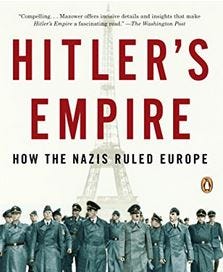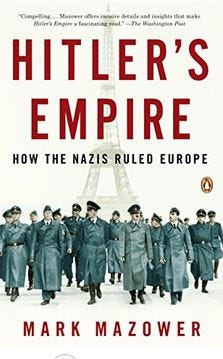Mark Mazower’s “Hitler’s Empire: How the Nazis ruled Europe” is a magisterial book.
I read it on vacation, and it is not a book I would suggest you take with you to the beach. Unless you want to spoil your vacation. But once you have made such a choice, you cannot stop reading it and the book will stay with you throughout your stay (and I believe much longer).
This Summer I read, almost back-to-back Adam Tooze’s “The deluge” and Mazower’s book. The first covers the period 1916-31, the second, the Nazi rule of Europe 1936-45. They can be practically read as a continuum, but they are two very different books. Tooze’s is, despite all the carnage of World War I and Russian Civil War, an optimistic book in which sincere or feigned idealism is battling conservatism and militarism. As I wrote in my review of Tooze’s book, the emphasis on the failed promise of liberal democracy (but a promise still it was) is a thread that runs through most of the book. Mazower’s book, on the other hand, is unfailingly grim and this is not only because the topic he writes about is much more sinister. The tone is bleaker. It is a book about the unremitting evil. It is the steady accumulation of murders, betrayals, massacres, retaliations, burned villages, conquests, and annihilation that makes for a despairing and yet compelling read. Europe was indeed, as another of Mazower’s book is titled, the dark continent.
Here I would like to discuss another aspect of Mazower’s book that is implicit throughout but is mentioned rather discreetly only in the concluding chapter. It concerns the place of the Second World War in global history. The conventional opinion is that the Second War should be regarded as a continuation of the First. While the First was produced by competing imperialisms, the Second was the outcome of the very imperfect settlement imposed at the end of the War, and the difference in interpretations as to how the War really ended (was it an armistice, or was it an unconditional surrender).
But that interpretation is (perhaps) faulty because it cannot account for the most distinctive character of the World War II, namely that it was the war of extermination in the East (including the Shoah). That is where Mazower’s placing of the War in a much longer European imperial context makes sense.
The key features of Nazi policies of “racial” superiority, colonization of land and conscious destruction of ethnic groups cannot be understood but as an extreme, or even extravagant, form of European colonialism, as it existed from the 15th century onward. If one thinks of the Soviet Russia as of Africa or indigenous American continent (as it seemed to the Nazis), then Nazi policy of mass extermination and (more liberally) enslavement of the Slavic population that would provide forced labor for the German aristocracy living in agro-towns dotted across the plains of Russia does not look much different from what happened for several centuries in the mines of Potasi, in the Congo, in the ante-bellum South of the United States, in the Dutch Java or indeed in German-ruled Namibia.
The creation of two ethically and racially distinct social classes, with no interaction and with one openly exploiting another is exactly how European colonialism presented itself to the rest of the world. As Aimė Cėsaire, quoted at the end of the book, wrote (I paraphrase) “Nazism was the application of colonialism to Europe”.
There were, however, some differences that made the realization of this dream of conquest and domination unrealizable for the Nazis.
The technological and military gap between the “master” class and the Untermenschen was much smaller, and at the end it got even overturned in the military sphere. By 1942, the Soviet Union was producing more airplanes and tanks than Germany with all her factories in conquered Europe. The technological gap was indeed much smaller than it seemed to the Germans, and than it objectively was between the European conquerors and the peoples of Africa or the Americas. Tiny forces of Spaniards or English could conquer huge spaces and rule many people because of enormous superiority of their military power. But this was not the case in Europe. In other words, when the technological (military) gap between two groups is small, a complete annihilation of one by another is impossible.
The Nazis were blinded to this, not only by their misjudgment about the technological development of Russia, but also by their belief in rigid racial hierarchy where the very fact that such hierarchy existed (as they believed) made it impossible to entertain the possibility that the lower classes might rise sufficiently to challenge the “masters”. The rigidity of self-created racial hierarchy blinded them to reality.
The second difference between the Nazis and classical European imperialism was that racial hierarchy, pushed to its extreme, and leading to the attempted annihilation of the entire ethnic groups (Holocaust) was not motivated by economic interests of the elite but took place, as it were, outside it. Mazower makes very clear the tension that existed throughout the Nazi rule between economic needs for more forced labor, both in European factories and in the fields in the conquered territories in Poland, the Ukraine and Belorussia, and the ideologically-motivated drive to exterminate the “inferior races”. The military and civilian administrations tended to prefer the former approach (exploitation to death through labor), the SS the latter (pure destruction). This single-minded pursuit of annihilation, regardless of, or even against, economic benefits, was not something that existed in European colonialism.
The rigidity of racial hierarchy was such that the same Nazi leaders were arguing for forced labor vs. annihilation for one group, and for the opposite for another group. This was the case of Hans Frank, the head of the General Government of rump Poland, who tried to protect Poles from some random killings because he needed them to deliver grain but was eager to kill as many Jews as possible. (Although even he balked at thousands of “new” Jews being pushed to his territories as the “death camps” were already working at capacity.)
It is this macabre and economically and politically irrational drive toward extermination that might have differentiated colonialism as applied to Europe from colonialism applied elsewhere. But establishing racial hierarchy, believing in eugenics, being indifferent to the death of the “lower races”, creating a system of forced labor, shooting or maiming people who do not deliver their quotas of produce was not exactly new. Aimė Cėsaire might have been right.




Hi Branco,
Those are two very interesting books to read back to back. I disagree with two ideas in this essay. The first idea is the notion of German military superiority in 1941. The gap was the other way around, although the Nazis did drink their own Kool-Aid after Guderian's triumph in France, as did the Anglo-Saxons. But Max Werner knew better and he was soon working for the OSS. See my https://www.researchgate.net/publication/321837484_Western_perceptions_of_Soviet_strength_during_the_Soviet-German_War that I wrote under Tooze's supervision.
The Nazi vision was not to replicate the British or French empires in the East. Their vision to was replicate the American achievement. What they had in mind was settler colonialism at a continental scale, not political and economic domination of the East. The Americans had replaced the native population over centuries; the Nazis wanted to do it in years. Germs had played a larger role than violence in America; the Nazis tried to use genocide to achieve the same result. The effort floundered because of the refusal of the Red Army to capitulate. We must not be confused by the complicated system of slave labor that emerged and the challenges of German population policy in the early-1940s. That was not the intent. They had made plans to actually exterminate more than 100m people in the East to make way for German homesteaders. That was no longer a possibility once the German army was stopped in its tracks. What obtained in the deep rear of the Soviet-German frontlines had NOT been planned for. What emerged instead was a make-shift system, made necessary by the failure to achieve strategic objectives in the war against the Soviet Union. The Holocaust itself emerged from a bureaucratic logic, as argued by Bauman, and Aly and Heim. See my https://policytensor.substack.com/p/physical-anthropology-and-nazi-population-policy for a short summary.
So, the appropriate model is to be found not in Anglo-French empires or even in the Iberian empires in the New World, but Anglo-Saxon settler colonies. They very consciously wanted to replicate the American achievement. And they were driven to do so by the specter of being reduced to the status of Sweden and subject to permanent Anglo-Saxon hegemony — Churchill's 'pyramids of peace' — see the introduction in The Deluge.
Anusar